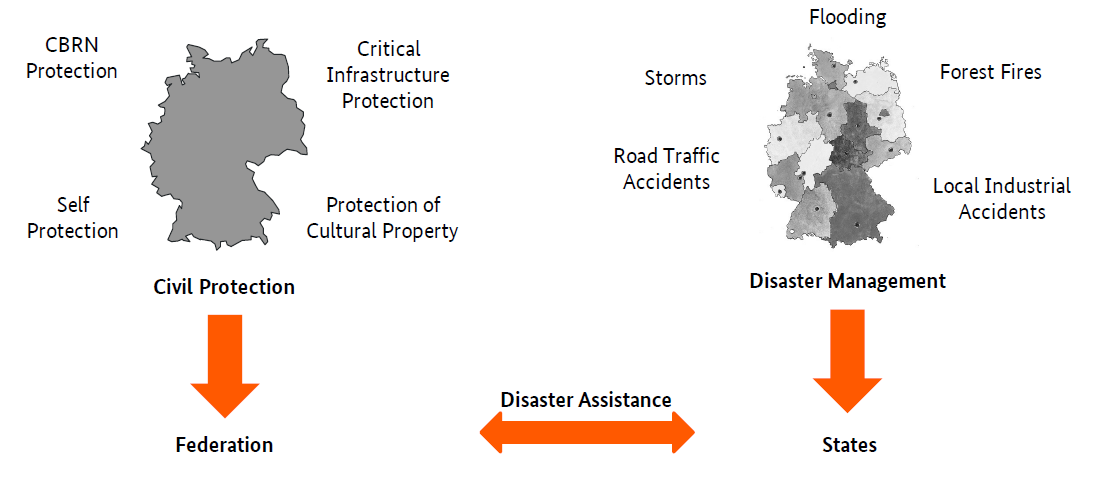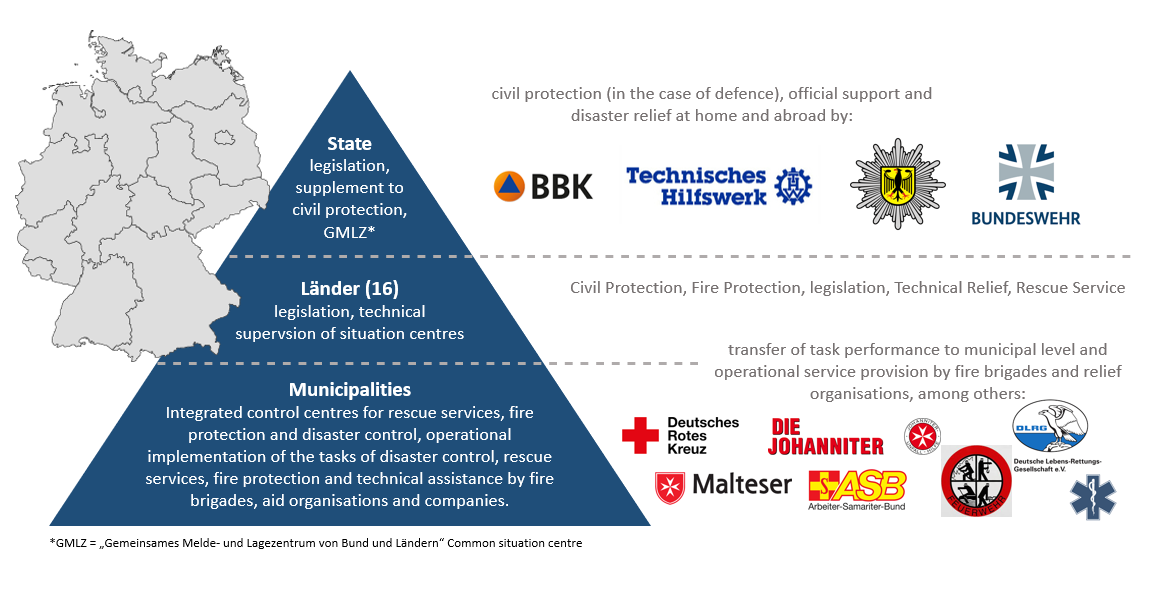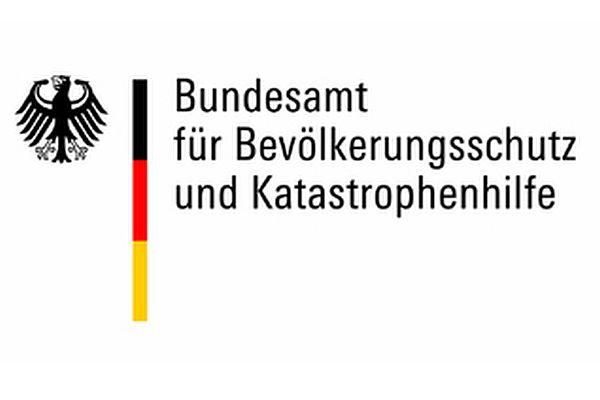Civil Protection in Germany
This topic page provides an overview of the protection of the population, its terminology and its actors in Germany, which includes Civil Protection and Disaster Management.
© Pixabay / Jacqueline Jacobs
Civil Protection in Germany
Storms, natural hazards and extreme events can quickly become a danger to people and the environment. But climate change, extreme urbanization, power failures and fires also offer potential dangers.
“Protection of the population” – being used instead of the english term “Civil Protection” in Germany, provides public safety and averts damage in the event of dangerous situations. It consists of Civil Protection and Disaster Management and is a task for society as a whole.
A disaster is said to occur when the functioning of a community or society is impaired or interrupted and, as a result, high levels of human, material, economic and environmental damage occur that cannot be dealt with on their own and therefore require an administrative act (BBK 2023, BPB 2021).
Preparedness measures can help to reduce the consequences and impact of a disaster. Depending on the hazard and personal circumstances, the precautionary measures to be taken may vary (BBK 2023).
In the following, we will first describe the protection of the population, then go into detail about the actors, and finally present the voluntary work that is fundamental for the protection of the population, as well as offering further information for individual preparedness.
What is protection of the population ?
Protection of the population in Germany represents a security system for society as a whole and is assigned to public safety and hazard prevention. The competencies in the area of protection of the population are divided among the levels of the state (federal government), the Länder and the municipalities (BBK 2023). Civil Protection tasks and measures are carried out by the federal government, while the Länder are responsible for Disaster Management. The municipalities are responsible, among other things, for everyday events, rescue services, fire protection, and technical assistance (BBK 2023).
What is Civil Protection ?
The state is responsible for Civil Protection (Defense). The federal government takes action for example in the event of terrorist attacks, self-defense and CBRN hazards and provides support in the protection of cultural assets and critical infrastructure. Civil Protection thus has the responsibility to protect the population, their homes and workplaces, important civilian offices, businesses, facilities and installations, and cultural heritage from the effects of war through nonmilitary measures and, if necessary, to mitigate or eliminate their consequences. Self-help measures by the population are supported by the authorities. The scope of activities of civil defense includes self-protection, warning of the population, protective construction, residence regulation, measures for the protection of health and the protection of cultural heritage (Bundesministerium für Justiz 2023).
The interrelations between Civil Protection and Disaster Managment are governed by the Civil Protection and Disaster Assistance Act (ZSKG). According to this law, Disaster Managment actors also participate in Civil Protection in the event of defense. For this purpose, they receive resources and supplementary equipment from the federal government.
Responsibilities and terminology in Civil Protection can differ between the Länder, as they have legislative competence in Civil Protection. In essence, however, the structures are similar. Coordination and political responsibility initially lie with the mayors or district administrators as representatives of the relevant local Disaster Manangment authorities, supported by Disaster Management staffs and the respective technical task forces. If necessary, crisis management teams or coordination groups can be set up at higher levels of government or at interstate and/or interdepartmental level (Bundesministerium für Justiz und Verbraucherschutz 2009).
What is disaster management ?
Disaster Management is a governmental task for which the Länder are responsible by law and which is carried out primarily by the municipalities. Disasters include events such as storms, forest fires, floods, traffic accidents and local industrial accidents. The state can provide so-called disaster relief with its forces and resources and support the states. Disaster Management draws up emergency plans and deployment contingents and, in the event of a disaster, provides appropriate rapid and targeted assistance for people, animals and the environment (Bundesministerium des Innern und für Heimat 2023).
Actors of Protection of the Population
In Germany, different state and public actors at different levels as well as private aid and relief organizations work together in a disaster situation. The Basic Law regulates which of the actors is responsible and when. A suitable, clear representation shows the system structures in the form of a pyramid (see Fig. 1). The pyramid is divided into the three administrative levels of the Federal Republic.
The municipal level delegates operational tasks in Disaster Management to private and public entities and institutions. These include, for example:
In addition to fire departments, rescue services and the voluntary aid organizations, Germany also has special authorities and organizations such as the Federal Office of Civil Protection and Disaster Assistance (BBK) or the Federal Agency for Technical Relief (THW). In the event of major crises and disaster situations, federal forces such as the THW, the Federal Police and the Bundeswehr can provide support within the framework of administrative assistance (ADRA 2022).
The Federal Foreign Office, as well as the Federal Ministry for Economic Cooperation and Development (BMZ), work together in projects with non-governmental organizations, the United Nations, organizations of the Red Cross and Red Crescent Movement and the Society for International Cooperation (GIZ) to improve disaster preparedness worldwide.
Volunteer
Volunteering is essential for the successful functioning of Civil Protection and Disaster Management (ADRA 2022). It is estimated that around 1.7 million volunteers are organized in civil protection, who are responsible for 90% of civil protection operations (BBK 2023). However, numerous challenges affect the attractiveness of volunteering in the protection of the population, including the suspension of compulsory military service, changing demands on employees, funding cuts, and demographic changes (BBK 2023).
Like the THW, the BBK also focuses on the topic of volunteerism in order to secure and promote volunteerism in protection of the population in the long term (BBK 2023). Volunteers in fire departments, relief organizations and the THW must not experienceany disadvantages in their employment or service relationship as a result of their commitment. The Federal Volunteer Service also offers the opportunity to become involved in Disaster Management on a full-time basis for a maximum of 24 months.
You can read about how you can volunteer with the respective emergency organizations, for example, on this page and in the BBK’s campaign “Mit dir für uns alle” (“With you for all of us”).
Created: July 2023
Weitere Links
Further links
NINA - Emergency information and news app
NINA warns of hazards, such as floods and other major emergencies, throughout Germany and, if necessary, on a site-by-site basis
KatRiMa
KatRiMa is a participatory information platform on actors, strategies, instruments or best practices of disaster risk management in and through Germany.
WarnWetter App from DWD
With the WarnWetter App from DWD, you are always up to date, even on the go. The free app from the DWD provides emergency services and the general public with important information on the current warning and weather situation.
KATWARN
KATWARN directs official warnings and recommendations for action to affected people. Authorized authorities and security organizations alone decide on content, timing and scope.
Cell Broadcast
Cell Broadcast is a cellular service that allows alerts to be sent directly to a cell phone or smartphone.
Further literature on individual prevention
- BBK: Guidebook for emergency preparedness and proper action in emergency situations.
- Deutsches Rotes Kreuz: DRK disaster preparedness – perfectly prepared for emergencies
- Bundesverbandes für den Selbstschutz 1081: Precautionary package for self-protection
- BBK: Brochures, documents and tips for various emergency situations
Current Information
Organizations call for reforms in civil protection
Five major aid organizations - ASB, DLRG, DRK, Johanniter and Malteser - are calling for far-reaching reforms in civil protection in a joint position paper. In the face of increasing natural disasters, they are pushing for integrated, nationwide crisis management that...
Thuringia’s Interior Minister Maier on disaster control
Thuringia's Minister of the Interior, Georg Maier, believes that violence against emergency services is primarily a social problem. In an interview with the magazine Behörden Spiegel, he emphasizes that existing laws are sufficient and instead advocates education and...
















